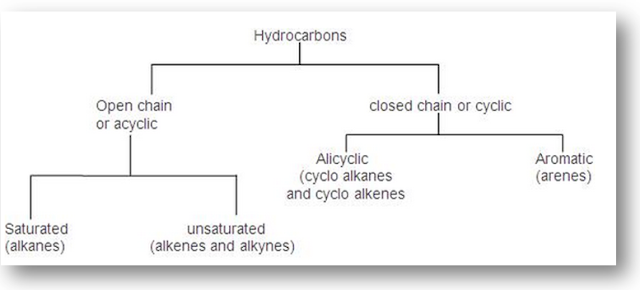(a)
Ether (b) Thiol (c)
Ester (d) Acid amide
2.
Which one of the following solvents is unlikely to dissolve
an organic compound?
(a)
Water (b)
Benzene (c)
Chloroform (d) Ether
3.
Cyano group is present in
(a)
Alkane nitriles (b) Nitro compounds
(c)
Thiol compounds (d) None of them
4.
Cyclohexane is an example of
(a)
Saturated hydrocarbons
(b)
Unsaturated hydrocarbons
(c)
Alicyclic hydrocarbons (d) Aromatic hydrocarbons 26. Acetic acid derives its name from
27.
In ________ reduction a ketone is reduced to an alkane using
Zinc amalgam and hydrochloric acid
(a) Clemmensen (b) Wolf kishrer (c)
Kolbe (d) None of them
28.
____________ decomposed on treatment with water or dilute
acid to give alkanes.
(a) Alcohol (b) Alkene (c) Ketones
(d) Grignard reagent
29.
Addition of hydrogen halide over an unsymmetrical alkene is
governed by
(a) Einstein’s rule (b)
Barbara’a Rule (c) Markownikov’s rule (d) None of them
30.
Ethyne on oxidation with strong alkaline KMnO4
gives
(a) Glycol (b)
Glycerols (c) Glyoxal
(d) None
of them


31.
Ethyne contain ___________ - bonds

(a) One (b) Two (c)
Three (d) Four
32.
The correct order of reactivity of halogens with alkanes
is
(a) I2 > Br2 > Cl2
> F2 (b) I2 > Cl2
> F2 > Br2
(c)
F2 > Cl2 > I2 > Br2 (d) F2
> Cl2 > Br2 > I2
33.
Which product is not formed during the electrolysis of
potassium maleate.
(a)
KOH (b) Ethyne
(c) Ethene
(d) H2
34.
When sodium acetate is heated with soda lime, the product is
(a)
C3H8 (b)
C2H6 (c) CH4
(d)
None of these
35.
1-butyne and 2-butyne can be distinguished using
(a) Alkaline KMnO4 (b)
Br2 water
(c) Ammonical AgNO3 (d) None of these
36.
Ozonolysis of C2H4 forms
(a)
Glyoxal (b) Formic acid
(c) Acetone (d)
Methanal
37.
The number of acidic hydrogen in propyne is
(a)
1 (b)
2 (c)
3 (d)
4
38.
A carbonium ion is hybridized
(a) Sp2
(b)
Sp (c)
Sp3 (d)
dsp2
39.
Butene can have
(a)
Two position isomers (b) Cis-trans isomers
(c) Both a and b (d)
None of these
40.
The most important fraction of petroleum is
(a)
Kerosene oil (b) Diesel
(c)
Gasoline (d) Ligroin


No comments:
Post a Comment
Feel free to comment.Team NUST is here to listen you.